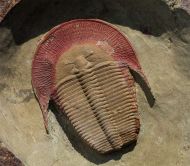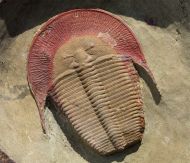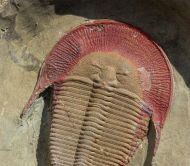Fossils for sale
Welcome back!
Sold:
Harpides cf grimmi. (Barrande, 1872)
Products description
Here is a fantastic specimen of a rare Moroccan trilobite from the genus Harpides. This Harpides exhibits exceptionally detailed preservation. The UV image reveals a quite clean glue line and a small restoration on the left edge of the cephalon. This restoration measures approximately 3 x 1.5 mm. It is a remarkable and beautiful display piece from the Lower Ordovician of Morocco. The trilobite itself is about 51 mm long and approximately 40 mm wide. This trilobite comes from the Fezouata Shale, finds from this site are mostly compared to Harpides grimmi BARRANDE, 1852 from the Czech Mílina Formation. The holotype of Harpides grimmi is the sole known specimen of this species and an iconic trilobite from the Barrandium region. Over the past 150 years, it has consistently been regarded as the rarest and most unique Bohemian trilobite. This specimen has been illustrated by numerous authors in field guides, popular books, and scientific papers, and it has even served as a symbol on book covers. The holotype was collected in the vicinity of the village of Holoubkov during the 1840s. It was found in iron-rich siltstone extracted from various outcrops in the region, likely associated with the Mílina Formation. However, the exact location of the discovery remains unresolved. Comparing the Moroccan material with the Czech specimens is challenging. Differences exist between the Fezouata Shale specimens and those from the Czech Republic. Neither the holotype nor other Czech finds exhibit a pronounced occipital node on the cephalon’s neck ring. Additionally, the prominent eye ridges and glabella appear distinct. Due to the scarcity of fragmentary Harpides grimmi specimens from the Czech Republic, determining whether these features represent intraspecific variation or species-level distinctions remains difficult. It is possible that the Fezouata Harpides represent an undescribed species. | |||
Location: | Ouled Slimane, Dra Region, South Marocco | ||
| Size Matrix: | about 98 x 118 mm | ||
| Age: | Lower Ordovician, Arenig, Floian, Fezouata -shale (Ca. 485 Mill. Years) | ||
Product no.: 11468











